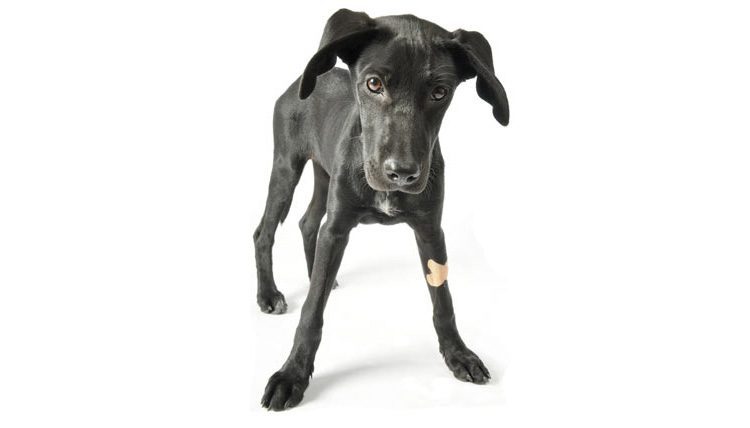how to clean a dog wound

How to Clean Wounds on your Pets
By isak, May 29, 2009
Deep wounds that cut through the skin and into the flesh will need stitches within 2-4 hours to heal most effectively. Shallow wounds and minor cuts may only require home treatment, but will heal best with first aid. Surface cuts that bleed a lot can appear more dangerous than they are, but are less prone to infection. Bleeding is a natural flushing mechanism meant to cleanse a wound. Cleaning a wound that bleeds excessively will just make the wound bleed more, so don't try to clean it.
Any time the skin is broken, contamination can occur from bacteria or other foreign matter — even fur — and potentially cause infection. Bleeding is a natural cleansing mechanism meant to flush out dangerous material. Clean non-bleeding wounds.
FIRST AID
- Muzzle your pet (unless there's a head injury or breathing problems). The wound will likely be sore and even the gentlest pet may try to bite you when you touch the wound. You can use a tie, a belt or a length of fabric to make a muzzle. In the case of a cat or a dog with a pushed in muzzle, put a pillowcase or a towel over the head.
- Stop the bleeding. Put direct pressure on the wound with a gauze pad or clean cloth. If blood soaks through, add another pad on top. Do not remove the first pad or you could disturb the clot that is forming.
- Get to the vet if the bleeding will not stop. A wound that bleeds heavily for more than 5 minutes has probably cut a vein or artery. Continue to apply pressure and get to the vet asap.
- Trim pet fur away from wound. Once the bleeding stops, check the wound. If the skin is broken, fill the wound with a water-soluble lubricant like K-Y Jelly before you clip. Cut the fur back from the wound with scissors or electric clippers so you have a 1-inch border around the wound. Cut the height of the hair to about 1/2-inch. Rinse the area thoroughly with warm water. The trimmed hair will stick to the jelly and wash out.
- Clean shallow wounds. Wash shallow cuts that don't go completely through the skin with an antiseptic liquid soap and water or a mild soap and water. Then pat dry with a clean, soft cloth. You can wipe the area around the wound with 3% Hydrogen Peroxide, but don't pour or dab it directly onto the wound. Hydrogen Peroxide can damage skin cells. Use an antibiotic cream like Neosporin or antiseptic spray like Bactine to help prevent infection.
- Flush out deep wounds. Stitches are needed when cuts and wounds are so deep that they gape open or if they are located near joints that will put tension on the wound and interfere with healing. Flush it with lukewarm water to wash out germs and debris. Using clean, disposable gloves, dislodge any remaining debris — dried blood, fur or other debris — with your finger. Then gently wash the area with mild soap and pat dry.
Salt water rinse — For open wounds that are infected, soak the wounded area in warm water or put a warm, wet cloth on the wound for 20 minutes three times a day. Use a warm saltwater solution containing 2 teaspoons of table salt per cup of warm water. - For puncture wounds like animal bites, call your vet. The vet will want to check the wound and probably prescribe antibiotics. Keep the wound open so it doesn't seal in any bacteria that could cause an infection.If you can't see your vet right away, apply a warm compress to the wound. You can use a wash cloth soaked in warm salt water (2 tsp of salt to one cup of water). Two to five times a day, hold the compress against the wound — 5 minutes on, 5 minutes off until the wash cloth cools. You can also fill a turkey baster or syringe (without the needle) with the salt water mixture, then squirt it gently into the wound until the liquid runs out clear. Apply an antibiotic ointment like Neosporin to minor cuts and wounds, but don't medicate deep wounds until the vet has stitched them closed.
- Bandage gaping wounds. Leave puncture wounds open, but protect gaping wounds with a bandage. Press a gauze pad or a clean towel over the wound and secure it with an Ace bandage and tape. Make sure the bandage is not too tight by slipping two fingers beneath the wrapping. You can also use Saran Wrap if you don't have an Ace bandage. For shoulder wounds, put a t-shirt on your animal.
Clean all wounds once or twice a day with Betadine and water. If the wound has a lot of blood and crust around it, clean the edges of the wound with 3% Hydrogen Peroxide. Puncture wounds may require oral antibiotics. Watch for fever, swelling, heat, obvious pain or discharge as these may be a sign of infection. Restrict your pets activity. Dogs often lick or chew their wounds, so use a bad tasting product on the area like Bitter Apple or put use an Elizabethan collar. Remove the collar at feeding time so your pet can reach the food.
16,349
how to clean a dog wound
Source: https://beingstray.com/how-to-clean-wounds-pets/
Posted by: mitchellexceplicted.blogspot.com

0 Response to "how to clean a dog wound"
Post a Comment